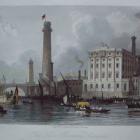London was already a major beer producer in the sixteenth century. However, beginning in the eighteenth century, urbanization and industrialization meant a sharp increase in scale for brewers. Because brewers required large quantities of sweet water for manufacturing their product, this also resulted in greater pressure on finding and maintaining consistent flows of water. Consequently, the beer industry significantly influenced the development of urban water distribution systems.

The Lion Brewery Lambeth. Water for making beer came from a well inside the building rather than from the River Thames.
The Lion Brewery Lambeth. Water for making beer came from a well inside the building rather than from the River Thames.
Engraved print by E. W. Radclife from an original drawing by T. Allom for Brayley’s “The Topographical History of Surrey,” 1842.
Click here to view Maritime Gallery source.
 This work is licensed under a Creative Commons Public Domain Mark 1.0 License.
This work is licensed under a Creative Commons Public Domain Mark 1.0 License.
The rapid growth of London’s population made it the largest city in Europe by 1800. While beer consumption in the rest of the continent declined, in the metropolis it rose. London brewers sold about 270 million liters of beer in 1699. A new type, porter, made with darker malt and more hops, proved popular with local drinkers. It had the advantage of being very stable and so easier to produce in large quantities. That led to bigger breweries and a sharply increasing demand for sweet water. The combination of all uses, including cleaning equipment, brought brewers’ total water use to over 1.3 million liters per day through most of the century. In spite of the success of the London breweries, their share of the city’s total water usage probably dropped from around 10 percent—a common level in major beer towns in sixteenth-century northern Europe—as the water needs of the growing population increased. For their water source, brewers typically relied on wells and on the New River, a stream created in 1613 to bring water from the nearby county of Hertford to the city.

The Whitbread Brewery was one of the most successful of the big London brewers in the eighteenth century. George Garrard’s painting of the Chiswell Street site in 1792 indicates both the scale of the plant and the reliance on horsepower, along with the beginnings of the use of steam power.
The Whitbread Brewery was one of the most successful of the big London brewers in the eighteenth century. George Garrard’s painting of the Chiswell Street site in 1792 indicates both the scale of the plant and the reliance on horsepower, along with the beginnings of the use of steam power.
Click here to view Wikimedia source.
 This work is licensed under a Creative Commons Public Domain Mark 1.0 License.
This work is licensed under a Creative Commons Public Domain Mark 1.0 License.
Breweries were almost invariably located along the Thames. That made it easier to bring in supplies of raw materials, like grain, as well as coal, used for heating the brew. It also eased distribution of the product. Because beer was mostly water, it was expensive to transport, and brewers preferred to remain located close to their customers rather than moving to outlying regions where there might be less competition for water resources. However, expansion of other industries in the city increased pollution, and producers increasingly worried about possible contamination. In 1786 Barclays, the predecessor of Barclay, Perkins, and Company, one of London’s biggest breweries located in Southwark, dug wells to increase water supplies. The wells were about 200 meters from the river and were filled by pipes that were about a meter below the surface of the Thames to prevent pollution from upstream. The arrangement was not entirely successful, since the Thames is a tidal river with considerable fluctuations in its water levels, so at low tide the piping could be fouled by whatever was near the surface.

Samuel Whitbread (1720–1796), portrait by Sir Joshua Reynolds. © National Portrait Gallery, London. Having made a fortune producing beer, he enjoyed considerable political influence as a long-time Member of Parliament. His career was similar to that of other successful eighteenth-century London brewers.
Samuel Whitbread (1720–1796), portrait by Sir Joshua Reynolds. © National Portrait Gallery, London. Having made a fortune producing beer, he enjoyed considerable political influence as a long-time Member of Parliament. His career was similar to that of other successful eighteenth-century London brewers.
Permission granted by the National Portrait Gallery, London.
 This work is licensed under a Creative Commons Public Domain Mark 1.0 License.
This work is licensed under a Creative Commons Public Domain Mark 1.0 License.
Barclays at the same time was getting over 150,000 liters of water a day from the Borough Water Works, a company founded in 1770 with the brewery as a principal customer. The trend toward reliance on firms, private in the eighteenth century and increasingly publically owned in the nineteenth, to supply cities with water was enhanced and promoted by brewers. In seventeenth-century Edinburgh and nineteenth-century Dublin, brewers had to invest in infrastructure to get the water they needed. In London they could rely on others to create the conduits they needed. Because they were large consistent users, able to contract to take more or less consistent quantities, firms with agreements to supply breweries were insulated from the dangers of commercial failure. That was true in London and in more and more other cities as industrial methods of brewing spread. Commercial suppliers knew their investments would pay off because of their major client and that they would have better political leverage for approval of their plans with the support of brewers. The greater control exercised over waterways, canalization, the closure of river branches, and the directing of flows into piping that began in the seventeenth century became common in the nineteenth as cities grew. In urban centers there were arguments in favor of changing the landscape, both urban and rural, to get consistent quality water supplies for health reasons. Sustaining industry, most notably brewing, was invariably part of any debate about what to do. The demand for water to make beer created the need to develop standards of supply. The demand also created the possibility of developing systems to bring larger quantities of water to London. Beer consumption and the role of beer in urban life created both a possibility and a need to remake the ways waters flowed.

The great vats of Barclay Perkins, 1847. A vat holding 1.23 million liters burst in 1814, causing extensive flooding in nearby streets and eight deaths. The incident inspired greater care in construction and a limit on vat size.
The great vats of Barclay Perkins, 1847. A vat holding 1.23 million liters burst in 1814, causing extensive flooding in nearby streets and eight deaths. The incident inspired greater care in construction and a limit on vat size.
Engraving in the Illustrated London News, 6 February 1847.
Permission granted by the Mary Evans Picture Gallery.
Source: www.anchorbrewing.com.
This work is used by permission of the copyright holder.
How to cite
Unger, Richard. “Brewing, Industrialization, and London Water Supplies.” Environment & Society Portal, Arcadia (Summer 2016), no. 9. Rachel Carson Center for Environment and Society. doi.org/10.5282/rcc/7618.
ISSN 2199-3408
Environment & Society Portal, Arcadia
 This work is licensed under a Creative Commons Attribution-NonCommercial-ShareAlike 4.0 International License.
This work is licensed under a Creative Commons Attribution-NonCommercial-ShareAlike 4.0 International License.
2016 Richard Unger
This refers only to the text and does not include any image rights.
Please click on an image to view its individual rights status.
- Lynch, Patrick, and John Vaizey. Guinness's Brewery in the Irish Economy, 1759–1876. Cambridge: Cambridge University Press, 1960.
- Mathias, Peter. The Brewing Industry in England, 1700–1830. Cambridge: Cambridge University Press, 1959.
- Tomory, Leslie. “The Question of Water Quality and London’s New River in the Eighteenth Century.” Social History of Medicine 27, no. 3 (2014): 488–507.
- Tomory, Leslie. “London’s Water Supply before 1800 and the Roots of the Networked City.” Technology and Culture 56, no. 3 (July 2015): 704–37.
- Tynan, Nicola. “London's Private Water Supply, 1582–1902.” In Reinventing Water and Wastewater Systems: Global Lessons for Improving Water Management, edited by P. Seidenstat, D. Haarmeyer, and S. Hakim, 341–60. New York: Wiley, 2002.
- Wilson, Richard G., and Terence R. Gourvish, eds. The Dynamics of the International Brewing Industry since 1800. London: Routledge, 1998.
- Log in to post comments
- Print page to PDF








